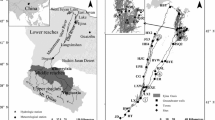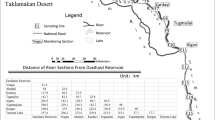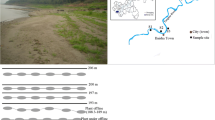Abstract
Because of long-term drying of the lower reaches of the Tarim River, oasis ecosystems are facing serious threats and have started to degenerate. An ecological water conveyance project has been started in the lower reaches of the Tarim River to save the degenerated ecosystem. The effects of ecological water conveyance on the ring width increments of Populus euphratica were studied by use of the trend analysis method, the moving t test technique, and a regression equation based on ring increment data from the past 40 years in the lower reaches of the Tarim River. Results showed that the ring increments of Populus euphratica in four monitoring transects along the river can be divided into two parts, 1970–2001 and 2002–2008. This division implies that ecological water conveyance had a positive effect on the increase of ring increments. The ring increments of Populus euphratica in Yinsu, Kardayii, Alagan, and Yiganbjma increased by 79.37, 174.5, 75.61, and 71.81% after ecological water conveyance. The years 2002, 2001, 2001, and 2002 were the transition years in the Yinsu, Alagan, Kardayi, and Yiganbjma transects, respectively. The ring width increments in Yinsu, Kardayi, Alagan, and Yiganbjma as a result of ecological water conveyance were 1.41, 0.987, 0.265, and 0.671 mm, respectively. The main cause of the changes in ring width increments was the rise of groundwater level. The results from this study should contribute to improved management of the ecosystems in the lower reaches of the Tarim River, and can also provide a scientific basis for implementing similar projects in other arid and semiarid areas.




Similar content being viewed by others
References
Battipaglia G, Saurer M, Cherubini P, Siegwolf RTW, Cotrufo MF (2009) Tree rings indicate different drought resistance of a native (Abies alba Mill.) and a nonnative (Picea abies (L.) Karst.) species co-occurring at a dry site in Southern Italy. For Ecol Manag 257:820–828
Brignolas F, Thierry C, Guerrier G, Boudouresque É (2000) Compared water deficit response of two Populus × euramericana clones, Luisa Avanzo and Dorskamp. Ann For Sci 57:261–266
Chen YN, Chen YP, Li WH, Zhang HF (2003) Response of the accumulation of proline in the bodies of Populus euphratica to the change of groundwater level at the lower reaches of Tarim River. Chin Sci Bull 48:958–961
Chen YN, Zhang XL, Zhu XM, Li WH, Zhang YM, Xu HL, Zhang HF, Chen YP (2004a) Analysis on the ecological benefits of the stream water conveyance to the dried-up river of the lower reaches of Tarim River, China. Sci China Ser D 47:1053–1064
Chen YP, Chen YN, Li WH, Zhang HF (2004b) Analysis on the physiological characteristic of Populus euphratica under drought stress in the lower reaches of Tarim River. Acta Bot Boreali Occident Sin 24:1943–1948 (in Chinese with English summary)
Cleverly JR, Smith SD, Sala A, Devitt DA (1997) Invasive capacity of Tamarix ramosissima in a Mojave desert floodplain: the role of drought. Oecologia 111:12–18
Cook ER (1985) A time series analysis approach to tree-ring standardization. Lamont-Doherty Geological Observatory, New York
Deng CZ, Zhang XM, Li L, Wu JX, Liu GJ, Yan HL, Zhu JT, Lv CY (2010) Effects of replenishing water into river on the growth of Populus euphratica in lower reaches of Tarim River. J Desert Res 30:312–318 (in Chinese with English summary)
Devitt DA, Piorkowski JM, Smith SD, Cleverly JR, Sala A (1997) Plant water relations of Tamarix ramosissmain response to the imposition and alleviation of soil moisture stress. J Arid Environ 36:527–540
Feng Q, Liu W, Si J, Su Y, Zhang Y (2005) Environmental effects of water resource development and use in the Tarim River basin of northwestern China. Environ Geol 48:202–210
Fritts HC (1976) Tree rings and climate. Academic Press, New York
Fu AH, Chen YN, Li WH (2008) Change on water potential of differently shaped leaves in Populus euphratica in lower reaches of Tarim River, Xinjiang. J Desert Res 28:83–88 (in Chinese with English summary)
Gullison JJ, Bourque CP (2001) Spatial prediction of tree and shrub succession in a small watershed in Northern Cape Breton Island, Nova Scotia, Canada. Ecol Model 137:181–189
Hao XM, Chen YN, Xu CC, Li WH (2008) Impacts of climate change and human activities on the surface runoff in the Tarim River Basin over the last fifty years. Water Resour Manag 22:1159–1171
Holmes RL (1983) Computer-assisted quality control in tree-ring dating and measurement. Tree-Ring Bull 43:69–78
Hou P, Beeton RJS, Carter RW, Dong XG, Li X (2007) Response to environmental flows in the lower Tarim River, Xinjiang, China: an ecological interpretation of water-table dynamics. J Environ Manage 83:383–391
Huete AR (1988) A soil-adjusted vegetation index. Remote Sens Environ 25:295–309
Li X, Zhou HF, Fan ZL (1998) Water resources utilization of Tarim River and land desertification effect analysis. J Desert Res 18:46–54 (in Chinese with English summary)
Liu DD, Chen XH, Lian YQ, Lou ZH (2010) Impacts of climate change and human activities on surface runoff in the Dongjiang River basin of China. Hydrol Process 24:1487–1495
Munoz-Reinoso JC (2001) Vegetation changes and groundwater abstraction in SW Donana, Spain. J Hydrol 242:197–209
Naumburg E, Mata-Gonzalez R, Hunter RG, McLendon T, Martin DW (2005) Phreatophytic vegetation and groundwater fluctuations: a review of current research and application of ecosystem response modeling with an emphasis on great basin vegetation. Environ Manage 35:726–740
Niinemets Ü (2010) Responses of forest trees to single and multiple environmental stresses from seedlings to mature plants: past stress history, stress interactions, tolerance and acclimation. For Ecol Manag 260:1623–1639
Page ES (1954) Continuous inspection schemes. Biometrika 41:100–115
Poiani KA, Johnson WC (1993) A spatial simulation model of hydrology and vegetation dynamics in semipermanent prairie wetlands. Ecol Appl 3:279–293
Raddi S, Cherubini P, Lauteri M, Magnani F (2009) The impact of sea erosion on coastal Pinus pinea stands: a diachronic analysis combining tree-rings and ecological markers. Forest Ecol Manag 257:773–781
Sano M, Furuta F, Sweda T (2010) Summer temperature variations in southern Kamchatka as reconstructed from a 247-year tree-ring chronology of Betula ermanii. J For Res 15:234–240
Stokes MA, Smiley TL (1968) An introduction to tree-ring dating. University of Chicago Press, Chicago
Sun Y, Wang LL, Chen J, Duan JP, Shao XM, Chen KL (2010) Growth characteristics and response to climate change of Larix Miller tree-ring in China. Sci China Ser D 53:871–879
Suresh HS, Dattaraja HS, Sukumar R (2010) Relationship between annual rainfall and tree mortality in a tropical dry forest: results of a 19-year study at Mudumalai, southern India. For Ecol Manag 259:762–769
Touchan R, Meko DM, Hughes MK (1999) A 396-year reconstruction of precipitation in Southern Jordan. J Am Water Resour Assoc 35:45–55
Touchan R, Xoplaki E, Funkhouser G, Luterbacher J, Hughes MK, Erkan N, Akkemik U, Stephan J (2005) Reconstructions of spring/summer precipitation for the Eastern Mediterranean from tree-ring widths and its connection to large-scale atmospheric circulation. Clim Dynam 25:7–98
Watmough SA, Hutchinson TC, Sager PS (1998) Changes in tree ring chemistry in sugar maple (Acer saccharum) along an urban–rural gradient in southern Ontario. Environ Pollut 101:381–390
Wu J, Tang DS (2010) The influence of water conveyances on restoration of vegetation to the lower reaches of Tarim River. Environ Earth Sci 59:967–975
Xu CC, Chen YN, Li WH, Chen YP (2006) Climate change and hydrological process response in the Tarim River Basin over the past 50 years. Chin Sci Bull 51(supp 1):25–36
Xu HL, Ye M, Song YD, Chen YN (2007) The natural vegetation responses to the groundwater change resulting from ecological water conveyances to the Lower Tarim River. Environ Monit Assess 131:37–48
Xu ZX, Liu ZF, Fu GB, Chen YN (2010) Trends of major hydroclimatic variables in the Tarim River basin during the past 50 years. J Arid Environ 74:256–267
Xu XY, Tong L, Li FS, Kang SZ, Qu YP (2011) Sap flow of irrigated Populus alba var. pyramidalis and its relationship with environmental factors and leaf area index in an arid region of Northwest China. J For Res 16:144–152
Yadav RR, Braeuning A, Singh J (2009) Tree ring inferred summer temperature variations over the last millennium in western Himalaya, India. Clim Dynam 36:1545–1554
Ye ZX, Chen YN, Li WH, Yan Y (2009) Effect of the ecological water conveyance project on environment in the Lower Tarim River, Xinjiang, China. Environ Monit Assess 149:9–17
Zu R, Gao Q, Qu J, Qiang M (2003) Environmental changes of oasis at southern margin of Tarim Basin, China. Environ Geol 44:639–644
Acknowledgments
The work was financially supported by the National Basic Research Program of China (973 Program, 2009CB421102) and National Natural Science Foundation of China (30970549,40971284). Special thanks are due to two anonymous reviewers for invaluable advice in preparing this manuscript. The authors would like to express their cordial gratitude for assistance in this research to Peng Zhang, Qingqing Zhang, Xinfeng Zhao and Xiaoli Shi.
Author information
Authors and Affiliations
Corresponding author
About this article
Cite this article
Yu, P., Xu, H., Ye, M. et al. Effects of ecological water conveyance on the ring increments of Populus euphratica in the lower reaches of Tarim River. J For Res 17, 413–420 (2012). https://doi.org/10.1007/s10310-011-0312-3
Received:
Accepted:
Published:
Issue Date:
DOI: https://doi.org/10.1007/s10310-011-0312-3




